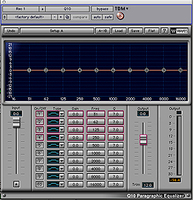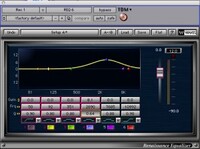![]() EQ is an essential tool in a mixers' bag of tricks. EQ was developed as a way to "equalize" differing sources to sound similar. It can alter the frequency characteristics of a recorded sound. It can enhance recordings by boosting, reducing or even removing certain frequencies. The simplest and most common EQ are what used to be called the "tone control" or the "treble" and "bass" knobs common on car radios or home receivers. There can also be additional controls such as a "presence" switch or a "bass boost" switch.
EQ is an essential tool in a mixers' bag of tricks. EQ was developed as a way to "equalize" differing sources to sound similar. It can alter the frequency characteristics of a recorded sound. It can enhance recordings by boosting, reducing or even removing certain frequencies. The simplest and most common EQ are what used to be called the "tone control" or the "treble" and "bass" knobs common on car radios or home receivers. There can also be additional controls such as a "presence" switch or a "bass boost" switch.
There are as many flavors in these controls as there are audio manufacturers but you get the idea. But caution must be used in the application of EQ. Digital Audio is no different than any thing else in life, you may be able to change it but that doesn't mean it's necessarily for the better. EQ can be an amazing tool, in the right hands, in the right room on the right material. It can be used to help clarify dialog tracks, remove murky or boomy frequencies and help the overall sound quality of a mix. Particularly if you have multiple audio tracks playing simultaneously EQ can help define one track from another by boosting or cutting particular frequencies.
 Human hearing of frequencies is calculated on a scale of hertz or cycles per second. The commonly defined range of human hearing is 20 hertz to 20,000 hertz per second. A graphical EQ device, be it a hardware version or a software plug-in like those shown here generally work within that range. (Depending on your age and life experiences your hearing may be markedly less than this…)
Human hearing of frequencies is calculated on a scale of hertz or cycles per second. The commonly defined range of human hearing is 20 hertz to 20,000 hertz per second. A graphical EQ device, be it a hardware version or a software plug-in like those shown here generally work within that range. (Depending on your age and life experiences your hearing may be markedly less than this…)
In the application of boosting or cutting particular frequencies there are also a few controls which determine how the boost or cut will be applied. The first is the particular frequency itself, the second is the amount of boost or cut, usually described in decibels, and third is the "Q" or width of the boost or cut. If the horizontal line is flat, as shown here, then no EQ processing is happening.
Looking at the photo on the left, you can see the controls just described. This particular EQ is a 10 band parametric EQ meaning that you can affect 10 different bands or frequencies at one time.
The graph indicates the frequency to be affected sorted with the low frequencies at the left of the graph to the high frequencies at the right. Each 'band' has several controls -- on/off, the type of "curve" to be applied, the gain or amount of the processing, the frequency where things are being applied, the Q of the processing and  the overall input of the source and the output after processing.
the overall input of the source and the output after processing.
The picture on the right shows a bell curve which looks sort of like a -- bell. This is a very common way to apply EQ to a particular frequency. The Q is set to very wide so it is affecting a wide range of frequencies that are near the key frequency. Applying EQ to satisfaction is to determine the central frequency to be affected, the size of the Q and the shape of the curve and the amount of gain that is being cut or boosted.
